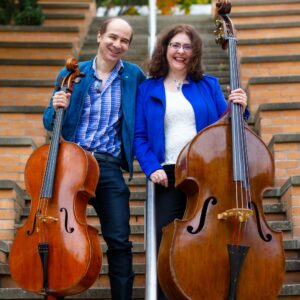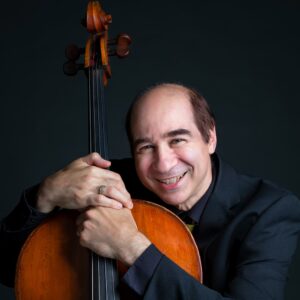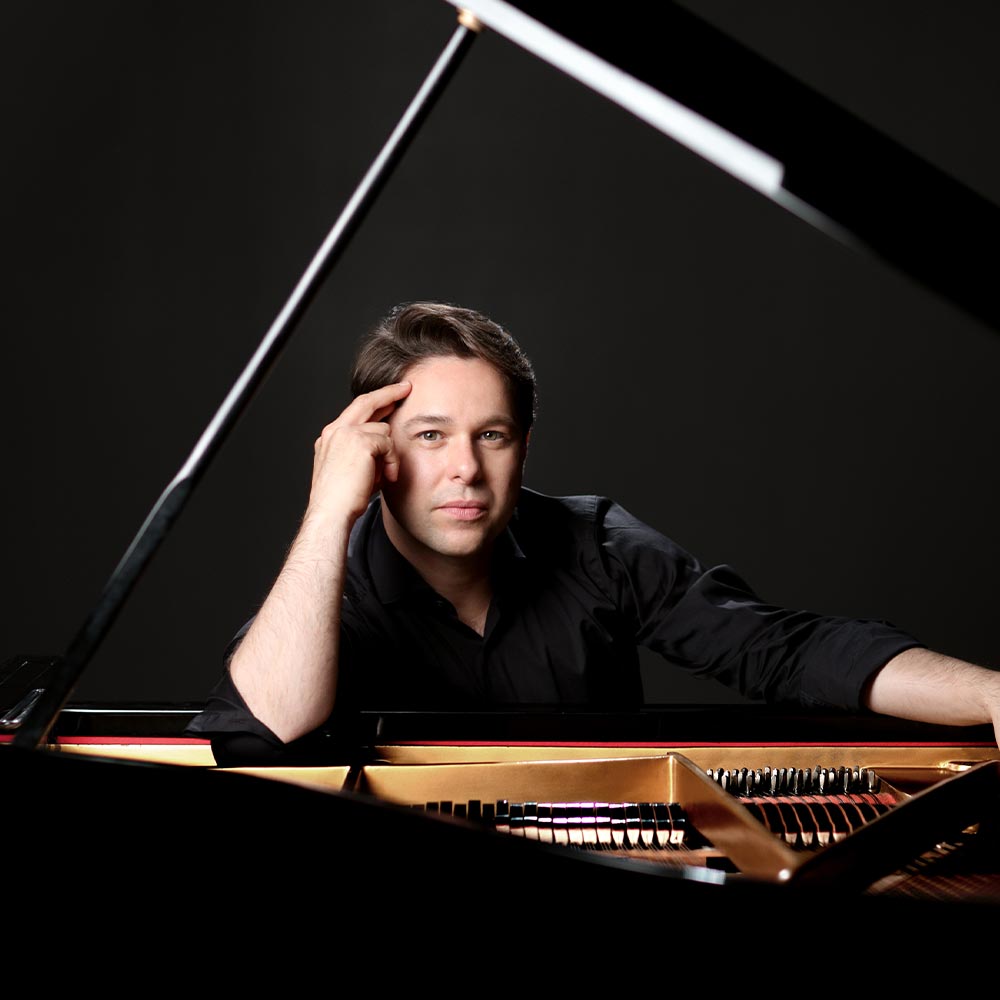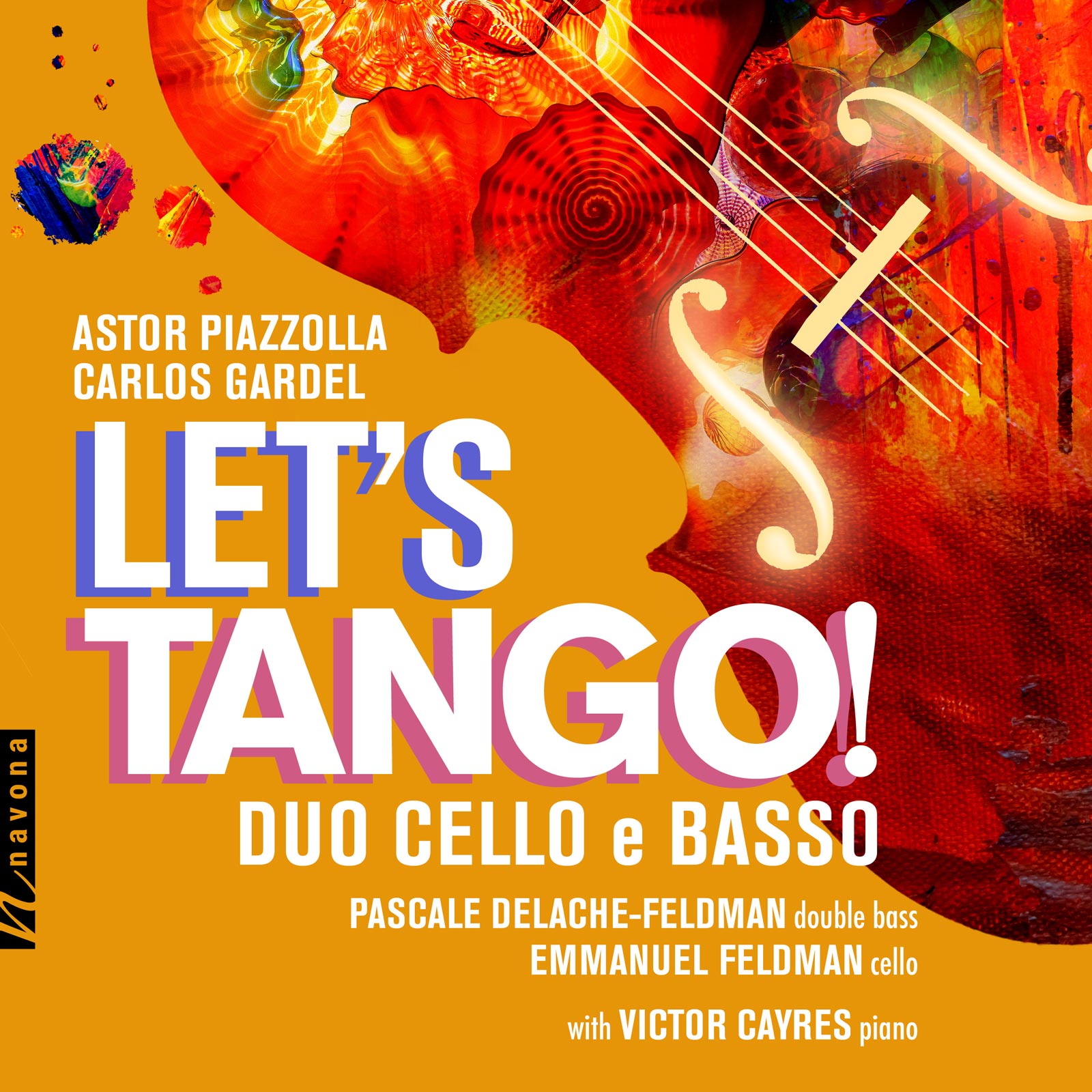Let’s Tango!
Astor Piazzolla composer
Carlos Gardel composer
Duo Cello e Basso
Pascale Delache-Feldman double bass
Emmanuel Feldman cello
Victor Cayres piano
On LET’S TANGO, Duo Cello e Basso with French double bassist Pascale Delache-Feldman and cellist Emmanuel Feldman invites listeners to experience some of the celebrated genre’s greatest masterpieces. Joined by pianist Victor Cayres, the centerpiece of the album is the duos’ arrangement of Piazzolla’s Four Seasons of Buenos Aires that they perform in concerts around the United States including a recent appearance at the Kennedy Center in Washington DC. Other Piazzolla works with piano include Kicho, an original work for solo double bass and Le Grand Tango, written originally for cellist Mstislav Rostropovich. The album also includes a trio arrangement of Por una Cabeza and El Dia que me Quieras by famed 20th century tango composer Carlos Gardel. Full of the longing and passion characteristic of tango music and paired with the rich dynamic range of the bass and cello, LET’S TANGO offers fresh new interpretations of these classic works.
Listen
Stream/Buy
Choose your platform
Track Listing & Credits
| # | Title | Composer | Performer | |
|---|---|---|---|---|
| 01 | El Dia Que Me Quieras | Carlos Gardel arr. Duo Cello e Basso, Regis Prudhomme | Emmanuel Feldman, cello; Pascale Delache-Feldman, double bass; Victor Cayres, piano | 4:42 |
| 02 | Por Una Cabeza | Carlos Gardel arr. Duo Cello e Basso, Regis Prudhomme | Emmanuel Feldman, cello; Pascale Delache-Feldman, double bass; Victor Cayres, piano | 3:19 |
| 03 | Kicho for double bass and piano | Astor Piazzolla | Pascale Delache-Feldman, double bass; Victor Cayres, piano | 6:52 |
| 04 | Le Grand Tango for cello and piano | Astor Piazzolla | Emmanuel Feldman, cello; Victor Cayres, piano | 11:05 |
| 05 | Five Tangos for cello and double bass: J'attends | Astor Piazzolla arr. Andreas Wiebecke-Gottstein | Emmanuel Feldman, cello; Pascale Delache-Feldman, double bass | 3:15 |
| 06 | Five Tangos for cello and double bass: La Misma Pena | Astor Piazzolla arr. Andreas Wiebecke-Gottstein | Emmanuel Feldman, cello; Pascale Delache-Feldman, double bass | 2:53 |
| 07 | Five Tangos for cello and double bass: Saint Louis en L'Ile | Astor Piazzolla arr. Andreas Wiebecke-Gottstein | Emmanuel Feldman, cello; Pascale Delache-Feldman, double bass | 2:45 |
| 08 | Five Tangos for cello and double bass: Guardia Nueva | Astor Piazzolla arr. Andreas Wiebecke-Gottstein | Emmanuel Feldman, cello; Pascale Delache-Feldman, double bass | 3:52 |
| 09 | Five Tangos for cello and double bass: Adios Nonino | Astor Piazzolla arr. Andreas Wiebecke-Gottstein | Emmanuel Feldman, cello; Pascale Delache-Feldman, double bass | 4:38 |
| 10 | Four Seasons of Buenos Aires: Verano Porteño (Summer) | Astor Piazzolla arr. José Bragato, Duo Cello e Basso | Emmanuel Feldman, cello; Pascale Delache-Feldman, double bass; Victor Cayres, piano | 6:59 |
| 11 | Four Seasons of Buenos Aires: Otoño Porteño (Autumn) | Astor Piazzolla arr. José Bragato, Duo Cello e Basso | Emmanuel Feldman, cello; Pascale Delache-Feldman, double bass; Victor Cayres, piano | 5:44 |
| 12 | Four Seasons of Buenos Aires: Invierno Porteño (Winter) | Astor Piazzolla arr. José Bragato, Duo Cello e Basso | Emmanuel Feldman, cello; Pascale Delache-Feldman, double bass; Victor Cayres, piano | 6:39 |
| 13 | Four Seasons of Buenos Aires: Primavera Porteña (Spring) | Astor Piazzolla arr. José Bragato, Duo Cello e Basso | Emmanuel Feldman, cello; Pascale Delache-Feldman, double bass; Victor Cayres, piano | 4:28 |
Recorded August 23-26, 2019 at Jordan Hall, New England Conservatory in Boston MA
Recording Session Producer Jesse Lewis
Recording Session Engineer Christopher Moretti
Editing Karl Doty
Mixing Christopher Moretti
Mastering Jesse Lewis, Christopher Moretti
Executive Producer Bob Lord
A&R Director Brandon MacNeil
A&R Chris Robinson
VP of Production Jan Košulič
Audio Director Lucas Paquette
Production Manager Martina Watzková
Production Assistant Adam Lysák
VP, Design & Marketing Brett Picknell
Art Director Ryan Harrison
Design Edward A. Fleming
Publicity Aidan Curran
Digital Marketing Manager Brett Iannucci
Artist Information

Duo Cello e Basso
Described by NPR's Ron Schachter as "a musical Lewis and Clark, opening up new musical territories," Duo Cello e Basso “unites passion with elegance” (Boston Globe). Cellist/composer Emmanuel Feldman and double bassist Pascale Delache-Feldman partner to perform repertoire ranging from Bartok, Mozart, and Rossini to Feldman, Pinkham, and Schnittke. With more than 20 commissions and premiers to their credit, the duo creates dynamic programming that surprises and energizes audiences.

Pascale Delache-Feldman
Praised by the New Music Connoisseur for her “technical certainty and musical imagination,” French double bassist Pascale Delache-Feldman has been described as “a gifted colorist who produced an entire range of orchestral effects” (Boston Phoenix). In her recent appearance at the Kennedy Center, Delache-Feldman performed her own arrangement of Astor Piazzolla’s Four Seasons of Buenos Aires, which is included in her Navona Records album LET’S TANGO with Duo Cello e Basso and pianist Victor Cayres. Other recital credits include performances at Radio France; Franz Liszt Academy, Hungary; and Teatro Victoria Eugenia, San Sebastian, Spain. As a soloist, she has performed with the Merrimack Valley Philharmonic, the North Shore Philharmonic, and the Greensboro Festival Orchestra.

Emmanuel Feldman
Hailed by John Williams as “an outstanding cellist and truly dedicated artist,” Emmanuel Feldman performs in the United States and abroad as a soloist, chamber musician, and composer. Described by Gramophone as “an artist who combines communicative urgency with tonal splendor,” Feldman’s recent release Our American Roots (Delos) includes Pulitzer Prize winning composer George Walker’s cello sonata. An enthusiastic collaborator, he has partnered in a wide range of performances with Bobby McFerrin, the Mark Morris Dance Group, Verona String Quartet, and Boston Pops.

Victor Cayres
Hailed as “spirit of a leader!” by La Liberté (Fribourg, Switzerland), Brazilian pianist Victor Cayres has earned praise for concerts with the Sine Nomine string quartet and as soloist with such orchestras as Boston Pops and Brno Philharmonic in the Czech Republic. He has been a guest artist at Banff Center for the Arts in Canada, Interlochen Center for the Arts, Boston University Tanglewood Institute, Claflin University, Illinois Wesleyan University, Western Washington University, Moscow’s Tchaikovsky Conservatory and State University for Arts and Culture. He has released recordings for Albany Records, PARMA Recordings, and Centaur Records with works by American contemporary composers David Owens, Joseph Summer, and John H. Wallace. Cayres frequently performs in Brazil, Europe, South Korea, and in prestigious venues in the United States such as Weill Hall at Carnegie Hall, Chicago’s Preston Bradley Hall, Boston’s Symphony Hall, and Jordan Hall. His concerts have been broadcast live at Brazil’s TV Cultura channel, Boston’s WGBH 99.5 All Classical, and Chicago’s WFMT Fine Arts Radio.



